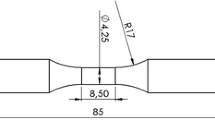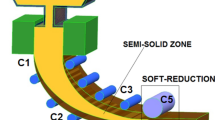The authors look into the possibility of using artificial neural networks for predicting the deformation characteristics of steels (the parameters of the Basquin–Manson–Coffin strain–life curve equation) based on static strength and plasticity characteristics, by constructing four independent neural networks with different configurations of input and output data. The prediction of parameters of the Basquin–Manson–Coffin equation and the fatigue life calculations by means of artificial neural networks are demonstrated to provide a better accuracy in comparison to the available conventional methods.











Similar content being viewed by others
References
V. T. Troshchenko and L. A. Khamaza, “Strain–life curves of steels and methods for determining the curve parameters. Part 1. Conventional methods,” Strength Mater., 42, No. 6, 647–659 (2010).
S. Haykin, Neural Networks: A Comprehensive Foundation, Second Edition, Prentice Hall, Upper Saddle River, NJ (1999).
J. Y. Kang, B. I. Choi, and H. J. Lee, “Application of artificial neural network for predicting plain strain fracture toughness using tensile test results,” Fatigue Fract. Eng. Mater. Struct., 29, 321–329 (2006).
M. E. Haque and K. V. Sudhakar, “ANN back-propagation prediction model for fracture toughness in microalloy steel,” Int. J. Fatigue, 24, 1003–1010 (2002).
A. Seibi and S. M. Al-Alawi, “Prediction of fracture toughness using artificial neural networks (ANNs),” Eng. Fract. Mech., 56, 311–319 (1997).
R. Ince, “Prediction of fracture parameters of concrete by artificial neural networks,” Eng. Fract. Mech., 71, 2143–2159 (2004).
J. Y. Kang and J. H. Song, “Neural network applications in determining the fatigue crack opening load,” Int. J. Fatigue, 20, 57–69 (1998).
M. E. Haque and K. V. Sudhakar, “ANN based prediction model for fatigue crack growth in DP steel,” Fatigue Fract. Eng. Mater. Struct., 23, 63–68 (2001).
M. E. Haque and K. V. Sudhakar, “Prediction of corrosion-fatigue behaviour of DP steel through artificial neural networks,” Int. J. Fatigue, 23, 1–4 (2001).
Y. Cheng, W. L. Huang, and C. Y. Zhou, “Artificial neural network technoligy for the data processing of on-line corrosion fatigue crack growth monitoring,” Int. J. Press. Vess. Piping, 76, 113–116 (1999).
K. Genel, “Application of arificial neural network for predicting strain-life fatigue properties of steels on the basis of tensile tests,” Int. J. Fatigue, 26, 1027–1035 (2004).
P. Artymiak, L. Bukowski, J. Feliks, et al., “Determination of S–N curves with the application of artifical neural networks,” Fatigue Fract. Eng. Mater. Struct., 22, 723–728 (1999).
V. Venkatesh and H. J. Rack, “A neural network approach to evaluated temperature creep-fatigue life prediction,” Fatigue Fract. Eng. Mater. Struct., 21, 225–234 (1999).
T. T. Pleune and O. K. Chopra, “Using artificial neural networks to predict the fatigue life of carbon and low-alloy steels,” Nucl. Eng. Design, 197, 1–12 (2000).
R. C. S. F. Junior, A. D. D. Neto, and E. M. F. Aquino, “Building of constant life diagrams of fatigue using artificial neural networks,” Int. J. Fatigue, 27, 746–751 (2005).
S. Malinov and W. Sha, “Software products for modelling and simulation in materials science,” Comput. Mater. Sci., 28, 179–198 (2003).
K. Genel, S. C. Kurnaz, and M. Durman, “Modelling of tribological properties of alumina fiber reinforced zinc-aluminum composites using artificial neural network,” Mater. Sci. Eng., A363, 203–210 (2002).
T. Sourmail, H. K. D. H. Bhadieshia, and D. J. MacKay, “Neural network model of creep strength of austenitic stainlees steels,” Mater. Sci. Tech., 8, 655–663 (2002).
V. T. Troshchenko, P. P. Lepikhin, L. A. Khamaza, and Yu. N. Babich, “Computerized data bank “Strength of Materials”,” Strength Mater., 41, No. 3, 235–242 (2009).
H. P. Lieurade and C. Maillard-Salin, “Low-cycle fatigue behavior of welded joints in high strength steels,” in: C. Amzallag, B. N. Leis, and P. Rabble (Eds.), Low-Cycle Fatigue and Life Prediction, ASTM STP 770 (1982), pp. 311–336.
M. Truchon, “Application of low-cycle fatigue test results to crack initiation from notches,” in: C. Amzallag, B. N. Leis, and P. Rabbe (Eds.), Low-Cycle Fatigue and Life Prediction, ASTM STP 770 (1982), pp. 254–268.
Author information
Authors and Affiliations
Additional information
Translated from Problemy Prochnosti, No. 1, pp. 5 – 26, January – February, 2011.
Rights and permissions
About this article
Cite this article
Troshchenko, V.T., Khamaza, L.A., Apostolyuk, V.A. et al. Strain–life curves of steels and methods for determining the curve parameters. Part 2. Methods based on the use of artificial neural networks. Strength Mater 43, 1–14 (2011). https://doi.org/10.1007/s11223-011-9262-4
Received:
Published:
Issue Date:
DOI: https://doi.org/10.1007/s11223-011-9262-4




